It's a Gas: Las Vegas Preserves Neon
For the Captain, Las Vegas offers the three greatest things in life: alcohol, lenient divorce laws, and alcohol.
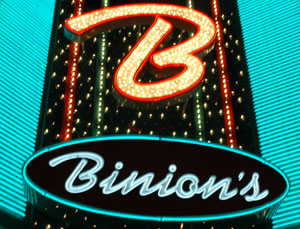 This week he's found himself in that desert town poking through a collection of old neon signs. Step back, folks, the Captain will be emitting a shimmering glow for the duration of the story.
This week he's found himself in that desert town poking through a collection of old neon signs. Step back, folks, the Captain will be emitting a shimmering glow for the duration of the story.
A framed blueprint hangs behind the desk of Melanie Coffee, media coordinator at The Neon Museum in Las Vegas.
The blue lines on the sheet sketch out the design for the Stardust hotel's neon sign - the billowy, cloud-like marquee and base support that is presently set in front of the property on the Strip.
"We love to collect signs from vintage hotels," she says of the museum's intentions. "When we see construction going up around a property or hear something, we'll ask if they will donate the sign."
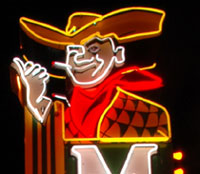 The "pillowtop," as it is known to locals in the neon industry, could be said to be a target of the museum since it will come down in 2007.
The "pillowtop," as it is known to locals in the neon industry, could be said to be a target of the museum since it will come down in 2007.
By displaying such signs in its 3-acre "boneyard" and restoring others for public view, the museum is actively preserving a piece of the ever-changing Las Vegas cityscape: the glowing glass tubes and blinking bulbs that have been pulling in gamblers and tourists for over 60 years.
The boneyard is two fenced-in lots located just north of the Fremont Street Experience on Las Vegas Blvd. Some of the over 100 signs are mounted with stands on the gravel and hardpan ground; others are leaning on their edge or against one another.
Visitors come to the museum for different reasons, explains Coffee.
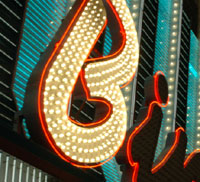 "It really depends on what they remember when they came here as kids with their families," she says. "We have signs that people will instantly recognize."
"It really depends on what they remember when they came here as kids with their families," she says. "We have signs that people will instantly recognize."
Many such legends include: a Binion's Horseshoe sign with its signature white front and red siding, shaped to match its name; a curvy Golden Nugget Gambling Hall number that includes an arrow pointing to the casino entrance.
A sign that called folks to the double jackpots at Sassy Sally's slot machines, one that asked gamblers to try their luck at the Tam O' Shanter, and an invitation for tourists to stay at the Jackpot Motel are lesser known.
The designs include varying bends and swoops. Thin glass tubing often lines each sign's edges and any lettering while standard light bulbs fill in the interior portions.
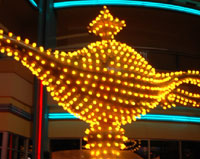 "As a rule, we try to stay away from plastic," she says as she strolls past a KFC bucket resting on its side.
"As a rule, we try to stay away from plastic," she says as she strolls past a KFC bucket resting on its side.
The oldest known sign is that of the Normandie Motel, a blue-gray medieval hatchet motif which dates back to the '40s.
"The Normandie is not only important to us because it is the oldest sign we know of here in the boneyard," Coffee says, "it was also designed by Betty Willis, who was a female sign designer active in the very male-dominated field of sign design in the '40s and '50s."
Willis' claim to fame is that she designed the world-famous "Welcome to Fabulous Las Vegas, Nevada" sign, installed in 1955 by the Young Electric Sign Company.
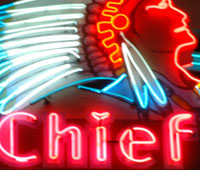 The fabrication process of each neon tube at that time was much the same as it is today. The glass is first heated until malleable and shaped by the craftsman. Electrodes for the wiring are attached to each end. A pump will then remove enough air to achieve nearly a vacuum state. For color, one of the noble gases, typically neon or argon, is then added to the glass chamber. The glow comes after the introduction of an electric charge from the electrode.
The fabrication process of each neon tube at that time was much the same as it is today. The glass is first heated until malleable and shaped by the craftsman. Electrodes for the wiring are attached to each end. A pump will then remove enough air to achieve nearly a vacuum state. For color, one of the noble gases, typically neon or argon, is then added to the glass chamber. The glow comes after the introduction of an electric charge from the electrode.
When it was installed by YESCO in 1945, the Boulder Club sign, which split the club's name into both horizontal and vertical sections adorned in bands of red, green, and yellow, is considered to be the beginnings Las Vegas' neon era. Three years later YESCO built eye-catchers for the Pioneer Club, Golden Nugget, and Las Vegas Club, further associating Vegas with the shimmer of electrically charged gases.
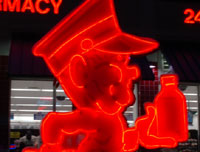 Because the glass tubes have such longevity and are so much brighter and flexible than their incandescent brethren, demand stayed steady beyond this initial boom. "Vegas Vic," the 75'-tall and 6-ton cowboy with extended left thumb that came to symbolize "Glitter Gulch," was installed in 1951.
Because the glass tubes have such longevity and are so much brighter and flexible than their incandescent brethren, demand stayed steady beyond this initial boom. "Vegas Vic," the 75'-tall and 6-ton cowboy with extended left thumb that came to symbolize "Glitter Gulch," was installed in 1951.
Coffee says that the top of the sign for the Silver Slipper property, a woman's high heel shoe, that now rests at the boneyard, is the most popular among visitors. "A lot of people have a lot of memories that surround the Silver Slipper," she says of the property whose lightbulb-decorated pump once spun atop the sign. "It is really iconic."
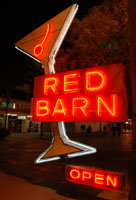 The idea to create a graveyard to Las Vegas' neon past has been around for roughly 20 years, explains Coffee. Since YESCO originally leased many of their signs to the establishments, they retained the ownership. When the sign was no longer usable, they collected them within their own property. Overwhelmed by the task of keeping up with public inquiries, The Neon Museum's boneyard was established as a non-profit entity in 1997.
The idea to create a graveyard to Las Vegas' neon past has been around for roughly 20 years, explains Coffee. Since YESCO originally leased many of their signs to the establishments, they retained the ownership. When the sign was no longer usable, they collected them within their own property. Overwhelmed by the task of keeping up with public inquiries, The Neon Museum's boneyard was established as a non-profit entity in 1997.
Time has taken its toll on the stock. Many bulbs are missing. Sockets are rusted and wires are dangling. Dents and accumulations of desert dust are common.
But plans are set to reclaim the lobby of the nearby La Concha motel, a giant shell-shaped entry, so that it can be used as an entryway for an indoor-outdoor gallery that will join the exiting two boneyard lots. The Neon Museum is slowly putting together the $800,000 needed.
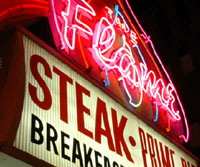 Through the help of various benefactors, the museum's restoration program has been actively restoring signs within the Fremont Street Experience over the past ten years. The first was the Hacienda Horse and Rider set in the center median of Las Vegas Blvd. The sign whose sweeping red curves helped highlight the steak dinners at the Flame Restaurant and the martini glass-shaped sign for the Red Barn bar are among the nine others that followed.
Through the help of various benefactors, the museum's restoration program has been actively restoring signs within the Fremont Street Experience over the past ten years. The first was the Hacienda Horse and Rider set in the center median of Las Vegas Blvd. The sign whose sweeping red curves helped highlight the steak dinners at the Flame Restaurant and the martini glass-shaped sign for the Red Barn bar are among the nine others that followed.
Since trademarks are still active on many of the signs, photo opportunities are very restrictive. But such media outlets as the Discovery Channel and Korean Esquire have used the boneyard as a shooting location. As well, rock band The Killers - in cowboy attire - are seen in the yard squaring off against four boomerang-toting vixens in the video for their single "All These That Things I've Done."
With many of The Strip properties turning to LED displays as Las Vegas continually evolves and expands seemingly by the month, Coffee hopes to see a resurgence in vintage-styled neon signage, perhaps as a part of the ongoing revitalization of downtown.
"The signs are Las Vegas' legacy," she says. "Vegas is known as being the oasis of light in the middle of the desert. The signs are an integral part of Las Vegas history."
Note: The Neon Museum is located at 821 Las Vegas Blvd. North.

